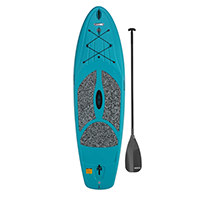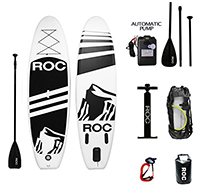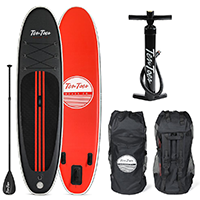So, it’s your first time adventuring out on a paddle board? No problem!
Paddle boarding is a great sport that’s easy to get the hang of. In this article, we’ll show you the ropes and give you our top 5 beginner tips and a good FAQ on beginner paddle boarding.
Of course, the first tip is this: You need the right paddle board to get started!
That’s why we’ve curated this list of the 9 best paddle boards for beginners on the market.
Check them out. Compare and contrast.
No matter what your preference is, there’s a board on this list with your name on it! So let’s get to it.
Best Paddle Board for Beginners
- Large hull rails to ensure maximum stability out on the ocean
- Great overall paddle board for all water activities
- Weight capacity of 230 lbs
- Inflatable; easy to travel with and store when not in use
- Large size dimensions for great stability
- Easy to get the hang of; just inflate and go
- Made of strong military grade material; indestructible
- Good length and width for maximum performance
- Includes full package of pump, leash, paddle, and strapped backpack
The Top 9
#1 Best Paddle Board For Beginners: Lifetime Horizon 100
When it comes to finding that perfect paddle board for the beginner, you need something that is wide, buoyant and with wide hull rails for maximum stability. The Lifetime Horizon is the perfect combination of everything you need all in one board. Coming in at ten feet in length and 34 inches in width and a total weight of 44 lbs, this board has the size dimensions great for balancing.
Other features included in the Lifetime Horizon: It comes with an adjustable paddle, meaning the length can change depending on the position you’re paddling in (on your knees versus on your feet). There is a center carrying handle to make it easier transporting the board to and from the beach. Also it has a maximum weight capacity of 230 lbs making it ideal for anybody to ride atop this board.
It’s a heavy-duty board that’s made with long term results in mind. Perfect for beginners, it even comes with a covered deck for extra traction beneath your feet. All in all this is one of the best stand up paddle board for beginners on the market.
Pro's
Con's
#2 Best Paddle Board For Beginners: Roc Inflatable SUP 10’5”
This board comes with all the essential gear needed for a great time learning to paddle board. It’s 10.5 feet long board is 6 inches thick for great stability out on the water. It’s a little narrower at 32 inches which will allow greater maneuverability. Also it’s an inflatable paddle board, meaning that there will be some squish beneath your feet so if you fall it’s no problem.
It comes with all the features needed for an inflatable board. A pump, leash, and storage backpack that allows for easy transport between car and water. No roof rack or large storage container needed to keep this paddle board with you, just deflate, pack it up, and go.
Made of tough military-grade material, this board flexes and molds so that you don’t have to worry about extensive damage being done to the perimeter of the board. The paddle is made of an alloy that floats well, which is a bonus when first learning to paddle board. That’s why we think this is the best inflatable paddle board for beginners.
These are some of the top reasons why it made our best paddle boards list. See our Fin Bin page for a deeper look!
Pro's
Con's
#3 Best Paddle Board For Beginners: Ten Toes Weekender 10’
Another great all around paddle board in the inflatable Ten Toes weekender. It’s ten feet in length and 30 inch wide midsection will have you cruising with speed out on the water. With an adjustable paddle, a comfortable strapped backpack, and inflating pump, this board comes with the full package.
Made of military grade PVC material this board is considered indestructible by surfboard standards. No problem washing up on rocky shores or accidentally bumping a wall or dropping the board on the street. This board will stay intact. Plus with the three removable fins, you don’t have to worry about these breaking off at any unexpected time.
Pro's
Con's
#4 Tower Inflatable 10’4”
Another 6 inch thick inflatable surfboard that’s sized about 10-foot-4 and 32 inches wide. It’s military strong PVC material prevents dings, rips, tears, damage of any kind. It has the non-slip top deck covering which allows for good traction no matter the conditions and no need to worry over a wax job. This paddle board is always ready to be pumped and go. And it’s durable! Run over the board fully inflated with your car and you’ll still be good to ride.
With a single large fin bringing up the rear of the board, you will have great maneuverability while riding. You’ve probably seen the tri-fin set up common on most boards. The middle fin is what gives boards that adequate ability to turn with ease. Having it be the large and center focus means that you’ll be able to maneuver very easily.
As a bonus, Tower boards come with the complete kit when it comes to paddle boarding. They provide the leash, the pump, the gauge, and the adjustable paddle so you’re ready to go as soon as you hit the water.
Pro's
Con's
#5 Isle Airtech 10’ Inflatable Yoga SUP
Not only is this one of the more stylish stand up paddle boards on the market but it also rocks a solid ten foot bass and 32 inch wide waist. With the Airtech patented construction, the entire paddle board only weighs 20 lbs but can handle riders and equipment of up to 240 lbs.
A great feature you’ll notice about this board is its wide shaped nose and tail. Oftentimes when you see paddle boards you’ll see it curve inward, letting fluid dynamics to take over and cause less drag. But with the wide front and back, it also comes as a large stable platform on which to do yoga on. Yes, in case you’re looking for a board with which to get into the hot new craze of stand up paddle board yoga, this is the board for you.
Not only does this make it a great stable paddle board for doing yoga, but it also means it’s a stable performer for beginners learning how to get the flow of paddling. There’s definitely a fluid motion when paddling on water that also rocks beneath you. Having this board beneath your feet will help you get your bearings before stepping up to skinnier, more maneuverable stand up paddle boards.
Pro's
Con's
#6 Ancheer Inflatable 10’
Another solid ten-foot inflatable paddle board is the Ancheer. Great for travel as it’s deflatable, light, and can easily be carried around on a trip. It has the bungee up front to stow away valuable equipment for fishing, scuba diving, or just taking along a lunch to enjoy out on the water. (Make sure it’s waterproof if you do though!)
With all the features you want on a paddle board, this board is ready to go whenever you are. It has the middle carrying handle, detachable center fin, flexible air valve, and made of durable PVC padding. This board can handle calm waters, rocky ocean chops, and even be taken onto rocky shores where other boards would get dinged up.
Pro's
Con's
#7 iRocker Cruiser Inflatable 10’6”
This stand up paddle board is a great inflatable board to learn the ropes on. Coming in at 10-foot-6 and 33 inches wide, this board has the large size dimensions you want in a beginner paddle board. It has one of the largest weight capacity at 400lbs and only weighs about 25 itself. This means, no matter the sport or activity you’re going for, you’re sure to be having a good time out on the water.
Another great feature of this board is that it comes with the full package. A backpack to carry and store the deflated board in is convenient for travel. The triple-action hand pump is sure to beat any other hand pump out there. The bungee rocker leash and adjustable fiberglass paddle are also there to make you’re all set to go.
With its durable military grade material and padded grip top deck, you won’t have to worry at all about damaging this board or slipping off. There is even a place for a shoulder strap or a kayak seat can be attached to the side of the board.
Pro's
Con's
#8 Peak 10’ Yoga Fitness Inflatable SUP
Never get bored with this paddle board. Included in this package is a waterproof accessory case that can hold your device out on the water. Imagine following along on your favorite yoga tutorial while out on the calm waters. With this ten foot by 32 inch board that only weighs 18 lbs fully inflated this might be one of the lightest paddle boards out on the market.
Beautiful aesthetics on the board. It has great color coordination between board to paddle to leash to backpack. Built to last with this military grade material and quality Korean drop-stitch so that you can be sure this more is never injured. It has a single detachable central fin and can be stored away with ease. The buoyant paddle ensures you never lose your paddle when you lose your balance.
Pro's
Con's
#9 Pathfinder 9’9” Inflatable SUP
A little smaller than the average board on this list. Coming in at 9-foot-9 and 5 inches thick, this is a board that might be better suited for the smaller user. Kids and young adults will find this board optimized to them as the smaller size will be great for their maneuverability. Also, with its standard bungee cross up front, there’s still room to bring along some extra equipment if needed.
This board will be more fun to learn surfing on as once you’ve caught the wave, you’ll find the smaller board to be more effective in turning and maneuvering the board with the wave. With the adjustable paddle, you’ll also ensure anybody of any height can enjoy this paddle board.
Pro's
Con's
Top 5 Stand Up Paddle Boarding Tips For Beginners
Paddle boarding is an incredible sport to get into, not only for the great benefits it offers (see FAQ below for a list of those benefits), but because it is fun whether you’re at a beach, a lake, or a river! Getting started is as easy as learning the ropes and getting out on the water. To ease your mind from land to water, here are our top 5 tips for beginner paddle boarders.
Safety First!
It’s important to understand your limitations. This means both in terms of your own physicality and swimming ability, as well as understanding the ocean and its currents. Be sure to wear a life jacket when paddle boarding in deeper waters. And ask the local lifeguard about currents and wave height. They’re there to help inform swimmers to be safe.
Wearing a Leash
Without a leash, a paddle board can become a 40 lb blunt object rocketing toward unaware swimmers. It’s important when first starting out to wear a leash as falling is a huge part of the learning process. If this happens near a wave, not only will you have to swim all the way into shore to retrieve your board, but you’ll also be putting the swimmers around in danger.
Practice on Calm Waters
Learning to paddle board is much easier on calm waters than in a choppy swell on the ocean. A lake or a smooth river will allow you to learn at your own pace the basics of balance and maintaining a flow when paddling. Oftentimes you’ll see beginners take their board straight out into the ocean and get discouraged when they find it to be difficult. If the ocean is the only thing you can try out the board in, try and go out on days with small waves. If you go out past the break, you’ll be rewarded with calmer waters as well.
Paddle Correctly
Too often, you’ll see a beginner using the paddle backwards. Not only is it a sure sign to look like a beginner, but it’s also incredibly inefficient. Be sure to be scooping the water not letting it run off the sides of the paddle. Take long powerful smooth strokes and do a few on each side before swapping to the other side. Soon enough, you’ll be looking like a veteran paddle boarder.
Take Care of Your Paddle Board
Last but not least, be sure to take proper care of your stand up paddle board. Not only will it look and feel better to surf on, but the board will last much longer with proper care. The three main factors to keep in mind to keep your paddle board in tip-top shape is sun, salt, and dings. Keeping a board in a board bag prevents the sun from bleaching the board and causing it to weaken over time. Washing your board clean of salt after each use is another easy tip as there are usually showers located by surf spots. Also, be sure never to go out and paddle when there is a ding or damage to the board. A small repair now can prevent large repairs later.
What To Consider When Buying a Beginner Paddle Board
Board Type (Touring Vs. Yoga Vs. iSup):
There are a few different types of beginner paddle boards. There’s some meant for long distance touring. These are generally longer, skinnier, and have less drag, allowing you to travel at higher speeds for longer distances.
Paddle boards meant for stretching exercises and yoga will have generally have a larger width throughout the board. You’ll notice a lot of boards curve heavily near the front and back of the board, this allows for less drag on the water. Yoga boards don’t do this and instead create a nice stable base to keep yourself upright while still allowing the gentle rocking of the ocean to seep through.
Inflatable paddle boards are pretty much indestructible compared with rigid boards. While they don’t quite have the same feel to them, they’re much easier to transport and are lightweight by comparison. They are less dangerous than the heavy thick paddle boards and are often preferred when fishing and doing yoga.
Length
The average length of paddle boards are around 9-12 feet. Any smaller and it’ll be hard to keep your balance. Longer boards generally have higher top speeds and can be used for touring. When looking to purchase a board remember the generalities. The longer the board, the more stable, the harder it is to turn. Also the heavier it will be.
Thickness
Thickness generally speaks about a board’s buoyancy and maneuverability. The thicker the board the heavier the board will be, the harder it will be to change course, and the more buoyant it will be. Having a thick board means balancing will be easier. So if balancing is not your strong suit, look for a board that is both lengthy, thick, and wide.
Width
Around 32 inches is the typical width of the board. Anything wider will make the board easier to balance on and make it harder to maneuver. Surfboards will often be skinnier in order to better handle waves and turn on them. The wider the board also means the heavier the board will be so keep that in mind.
Rocker
The rocker refers to the sides of the paddle board. You want to make sure for a beginner board that you understand the basics. That is, do the sides of the board stay flat and fall off, or do they curve off. Also does the board keep its width throughout the board or does it curve inward. The curvature of the board (from the bottom side) helps give a secondary assistance to staying upright. If the board keeps its shape throughout the length of it, that means the board will act as a stable platform. Often necessary for fishing and yoga.
Fins
Generally there are three different fin set-ups to keep in mind when it comes to paddle board. Three fins, one on each side and one further back in the center, is the standard. The two side fins help with stability while the central fin helps with turns and tracking. Having a long back central fin helps beginners turn better, while also helps keep the board going straight when you’re not turning. Removable fins are often wanted for inflatable surfboards for easier packing and traveling.
FAQ
how to paddle board for beginners?
When first starting out on your paddle board, there’s a few different steps to learn how to paddle board. One important pointer for beginners is to try and find the calmest waters to learn on. Whether that’s a still lake, a calm river, or a flat day out in the ocean. Learning on still water significantly helps beginners.
The next step is learning how to get the paddling flow down. You can start by practicing paddling on your knees. Oftentimes the paddle will be adjustable to fit either a standing or kneeling stance. Once you’re comfortable with paddling out on your knees, the next step is to practice standing. Having a little motion often helps beginners (like a bike it helps stay upright).
Take slow deep paddles, remembering to tighten your core and feel loose in the knees and hips. As you get used to the flow, you can start taking stronger and stronger paddles. Like anything, it’s important to take your time and not rush the learning process. There’s definitely a learning curve but once you start to get the hang of it, you’ll find yourself improving faster and faster.
Should I get an Inflatable SUP as a beginner?
This is a great question. Inflatable paddle boards have many benefits. We’ll list a few of them here so you can make the choice yourself. For one, people often enjoy the comfortability and stability that comes from inflatable stand up paddle boards. Whether it’s for fishing, yoga, or just learning how to balance when paddle, having an inflatable board is great for this. It also has a lot of give to it so you don’t have to worry about getting injured from in if you fall on it or on a wave.
On the other side of the paddle, having an inflatable board means that you won’t be able to just throw it in the water and go. You’ll have to inflate and deflate it as necessary for proper care. While it does make traveling and stowing it away easier, it’s important to think of the trade-offs. Some inflatable boards are known to bow after years of use while this is something you’d never have to worry about with a rigid board.
What Are Some Benefits Of Paddle Boarding?
Paddle boarding has some of the best benefits out there. Not only is it a great physical exercise that burns tons of calories. But it’s a full body workout and a spiritual cleanser at the same time! Let’s start with the physical aspect. When on the board you’ll be workout your shoulders, arms, chest, and abs to paddle correctly. You’ll also be working out your legs and stabilizer muscles too which are great for balancing on and off the water.
There are many well known mental benefits of being out in nature. Calm lakes, wading rivers, and rocky oceans are some of the top choices. Enjoy all the physical benefits of paddle boarding while also giving your mind a chance to relax and enjoy nature. You’ll find its calming, soothing effect to translate over to your personal life.
What is a good paddle board for beginners?
A good paddle board for beginners is one that is stable by both size dimension and shape. If balancing is the main issue, what you want to find is a wider board that stays wide throughout and doesn’t curve in as much. This will give you great control over the board and how you flow.
Determining whether you want a rigid or inflatable is another good starting point for beginners. Check out the FAQ above for more benefits of the inflatable board.
All around, the larger it is, the easier it’s going to learn paddling. The skinnier it is, the easier it will be to maneuver. Three fins is traditional. Having one large central fin, improves steering and the ability to turn.
How long does it take to learn as a beginner?
There’s definitely not a set time on how long it takes to learn how to paddle board. Reading through accounts of people’s experiences and you’ll see a wide range of stories. Some take one afternoon before they can be out there soaking up the sun like a pro. If you have prior experience with balancing activities like gymnastics, surfing, skateboarding, snowboarding, yoga, etc., you might have an easier time getting the hang of it. Balance, if there was one distinct attribute to pull out from all of them, is probably the most vital aspect to get better at. This being said, after a couple tries you will definitely get the hang of the rocking flow. It’s not a particularly hard sport to adjust to. Plus there are easy training grounds like still lakes and rivers. Or a calm ocean day past the break can be a good place to learn.
Final Thoughts - Which Should You Get?
There are so many factors involved with purchasing the perfect stand up paddle board. The first and foremost decision maker question to ask yourself is: Why do you want to get one? Is it for exercise, fishing, yoga, traversing the seas? This will help break down your choice.
Next go ahead and take a look around at some of the best paddle boards. Look at something like the Lifetime Horizon 100 for example. Ten feet in length, 34 inches of width stability, giving the beginner a little more room for error. All the features wanted in a stand up paddle board. It’s an all around great buy, and that’s why we think it’s the best.
And that’s just it. Trying to find the perfect board for you is a matter of interest and preference. All that’s important is that eventually one day, you get one. Paddle boarding is a lot more fun in person than online… That’s my opinion at least. Happy Paddling!















